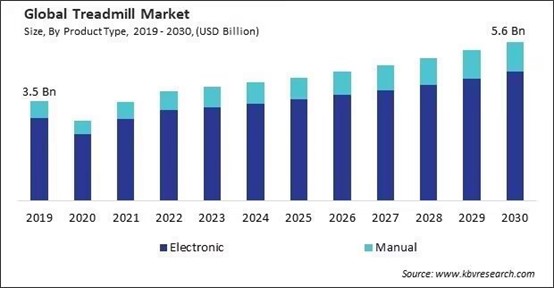The Basis and Challenges of the Fitness Equipment Market
Market Report DescriptionThe Global Treadmill Market size is expected to reach $5.6 billion by 2030, rising at a market growth of 4.9% CAGR during the forecast period. In the year 2022, the market attained a volume of 7,927.7 thousand units, experiencing a growth of 4.4% (2019-2022).There is a widespread awareness of health and wellness in North America, with individuals actively seeking ways to maintain an active lifestyle. Therefore, the North America region captured $1,282.5 million revenue in the market in 2022. Users in North America can access virtual classes, track their workouts, and participate in challenges, creating a sense of community and motivation and contributing to the growing regional market. The region's awareness of obesity-related health concerns and the desire for effective weight management solutions have fueled the demand for fitness equipment.

The promotion of fitness apparatus, such as treadmills, has been enormously impacted by celebrity endorsements and the influence of fitness influencers on social media platforms. Recommendations and endorsements from well-known figures impact consumer purchasing decisions. Celebrities and influencers often serve as sources of inspiration for their followers. Their commitment to fitness and healthy lifestyles, which may include these, inspires others to adopt similar habits. The aspirational aspect of following in the footsteps of admired figures drives the market growth. Influencers, particularly those active on social media platforms such as Instagram, YouTube, and TikTok, directly and widely impact consumer behavior. Additionally, treadmills are widely used in rehabilitation and physical therapy settings. The emphasis on rehabilitation as part of the healthcare system has contributed to the adoption of these in clinical environments. These are widely used in gait training, allowing therapists to analyze and correct walking patterns. Real-time observation of a patient's gait on a it enables precise adjustments, helping individuals relearn and improve their walking or running mechanics after surgery, injury, or neurological conditions. These are frequently used in orthopedic rehabilitation to aid in the recovery from musculoskeletal injuries, surgeries, or joint replacements. Thus, because of the growing focus on rehabilitation and physical therapy, the market is anticipated to increase significantly.However, Quality treadmills with advanced features and technology can be expensive. The high initial cost may deter budget-conscious consumers, limiting the market penetration of premium models. Consumers with high upfront costs may opt for lower-cost alternatives, such as outdoor activities, basic exercise equipment, or gym memberships. This shift away from these purchases can hinder market growth. High initial costs may prompt potential buyers to delay or reconsider their purchase decisions. Consumers may postpone buying it until they can allocate sufficient funds, contributing to a slower adoption rate. Other fitness equipment with lower upfront costs, such as resistance bands, dumbbells, or basic exercise mats, may gain preference over these among budget-conscious consumers. This competitive disadvantage can impact the market growth. The perception of high costs can create reluctance and resistance among potential buyers. Even if individuals acknowledge the health benefits of these workouts, the financial barrier may deter them from purchasing. Thus, high initial cost of these is a significant challenge that hampers the growth of market.


 Tel : +0592 6105769
Tel : +0592 6105769 Fax : +0592 6105769
Fax : +0592 6105769 Email : sales@wuwind.com
Email : sales@wuwind.com